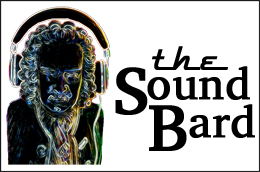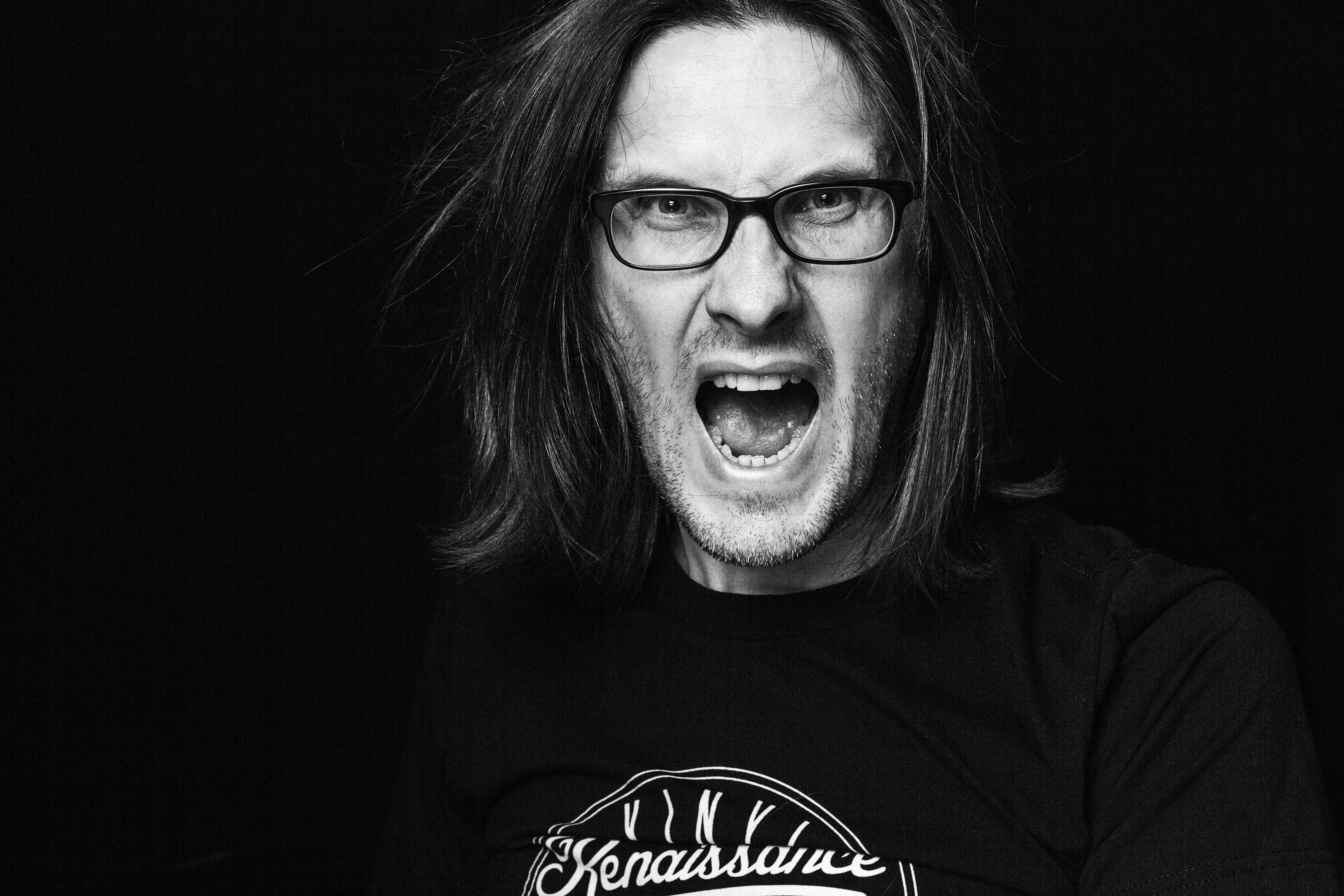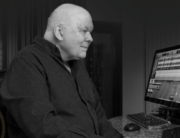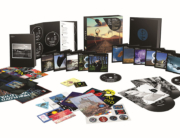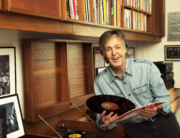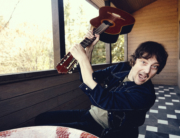BY MIKE METTLER – MAY 11, 2018
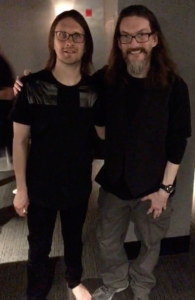
The Surround Maestro & The SoundBard, backstage at the Sony Playstation Theater in NYC, April 28, 2018.
Where do you go after you’ve reached the pinnacle of your aspirations as a musician? If you’re post-prog progenitor-cum-surround-sound guru Steven Wilson, you always zig, especially if people expect you to zag.
Following the heady sonics of his mind-blowing 2015 solo album Hand. Cannot. Erase., Wilson hit the reset button to emerge with the deeply layered To the Bone, out now in various formats via Caroline International, including an aurally stunning 96/24 hi-res mix available via HDtracks and a wholly enveloping 5.1 mix on Blu-ray.
“I think what’s different here is the emphasis on melodic songwriting and the pop sensibility in my music,” Wilson told me about the sound palette he created for To the Bone. “There was never a question for me that I wouldn’t follow my instincts. It’s something I’ve recognized in the careers of those people who have been inspiring to me over the years — Neil Young, Kate Bush, David Bowie, Frank Zappa, and Prince. These are all people who constantly redefined themselves, and had to deal with the difficulty of trying to take their audience with them when they did that.”
If anyone’s earned a comparable level of respect, it’s the man who continues to set the bar for hi-res recording and aural experimentation. Over in my Audiophile column on Digital Trends, Wilson and I discussed the songwriting techniques he deployed on To the Bone, the secrets of post-modern sound construction, and how to make music feel timeless in today’s polarizing sociopolitical arena. But here, exclusively on The SoundBard, Wilson and I get into the nitty-gritties of his overall production goals for To the Bone, as well as his ever-unique hi-res and 5.1 proclivities, along with firsthand details about some major surround releases to come — and some that are still on his wish list to do. Take it away, maestro.
 Mike Mettler: You worked with a different producer this time around, Paul Stacey (Oasis, The Kooks). Did you guys have a game-plan going into it in terms of, “here’s what I’m going for”? What were the conversations you had when you were in the pre-production mode for To the Bone?
Mike Mettler: You worked with a different producer this time around, Paul Stacey (Oasis, The Kooks). Did you guys have a game-plan going into it in terms of, “here’s what I’m going for”? What were the conversations you had when you were in the pre-production mode for To the Bone?
Steven Wilson: The first thing I did with Paul was sit down and listen to music on the first day — a lot of the artists I’ve mentioned to you before, like Peter Gabriel, Kate Bush, Tears for Fears, Talk Talk, and Prince, along with some other stuff. The idea was always keeping the focus on the song.
If there’s one thing I can say I might be guilty about on my previous solo records — and I’m proud of all of them, don’t get me wrong — is the conceptual element took over from the songwriting element and the melodic element.
This time, for example, a lot of the guitar solos on this record are done by me, and not by special guests. And the way I approach the solos on my songs is very much an extension of the vocals and the songwriting, because I am the songwriter, and I am the singer. It’s a very different approach.
Mettler: It’s almost like the approach somebody like a Kurt Cobain [of Nirvana], who, when he took a solo, would play off of the melody he wrote, and it would tie in with a theme that was already a part of the song. I feel like you’ve done that in certain places here.
Wilson: Yes. And that reminds me of the honor and the pleasure I had of working with the great [producer] Trevor Horn once. I did a guitar session for him, and I was getting ready to do the solo. This picks up exactly on what you were saying, Mike — I said to him, “What kind of solo do you want me to play?” And he looked at me and said, “Just play the vocal melody!” (chuckles) And that’s the songwriter, right there — you have to find and then play the melody on the guitar, rather than singing it. “Just play the vocal melody” — there’s something in that. It’s restating the hook, in a way.
That’s not quite what I’ve done here, but I feel I’ve taken the opportunity in the solos to almost extend the vocal melody into another section of the music, rather than having one of these dazzling musicians come in and go off on some incredible tangent. I think that would have been wrong for this record. This record felt like everything somehow had to be in service to the song. So, to answer your question, that was something Paul and I realized very early on that we wanted to do — to ultimately make it all about the song and its melody.
Early on, I found myself most excited by three songs that were on the first demo reel I had: “Pariah,” “People Who Eat Darkness,” and “Refuge.” They were not only the ones I was the most excited about, but I was playing them for my friends, and they were the songs they were getting into.
 Mettler: That’s good to hear. Speaking of “Refuge,” that’s a nice harmonica solo we’ve got going there, correct?
Mettler: That’s good to hear. Speaking of “Refuge,” that’s a nice harmonica solo we’ve got going there, correct?
Wilson: Yeah, and funny enough, that relates to the ’80s records we were talking about. I wasn’t interested in pastiching those records as much as I was in the philosophy behind them. One of the things I did do is I went out and found the harmonica player who played on [Talk Talk’s 1986 album] The Colour of Spring, and he also played with a band called The The. Do you know The The?
Mettler: Yeah yeah, you mean Matt Johnson’s band?
Wilson: Yeah, exactly. He’s the same guy who played on Mind Bomb (1989), a guy named Mark Feltham. I tracked him down, and he hadn’t been invited to play on a record like this for many years. In the ’80s, he was getting invited all the time. You’d hear his harmonica on a lot of records during those years.
 Mettler: He was fairly prevalent in those days, true. As I’ve mentioned to you before, I think The Colour of Spring still needs your surround touch.
Mettler: He was fairly prevalent in those days, true. As I’ve mentioned to you before, I think The Colour of Spring still needs your surround touch.
Wilson: I wanted to do it, and I even got a record label interested, but Mark [Hollis, the founder/leader of Talk Talk] said he didn’t want the record touched. And I respect that. but it’s a record that would sound fantastic in 5.1. But he put the kibosh on that, unfortunately.
Mettler: He’s the creator and it’s his vision, so we have to respect that, I agree. But there are certainly plenty of others. Some of them you mentioned to me recently, but I’m not sure which ones we can talk about publicly at the moment.
Wilson: Well, the ones that are on the record are, um, let’s think now. (slight pause) The Gentle Giant Three Piece Suite Blu-ray is announced for September 29, but I can’t mention the [redacted] yet, because they haven’t announced it.
Mettler: Hopefully they will fairly soon. It’s one of those things where you’ve got the literal two perfect worlds coming together, if ever there were the meeting of the exact minds that should be working on something like that together in 5.1.
Wilson: It’s certainly one of those catalogs that’s always been on my wish list, like the Kate Bush catalog, the Peter Gabriel catalog, or Brian Eno — I’d still love to get involved in those catalogs too.
 Mettler: You also mentioned the Roxy Music album you did when we talked about Hand. Cannot. Erase. back in 2015. Did you wind up doing the entire Roxy catalog, or. . .?
Mettler: You also mentioned the Roxy Music album you did when we talked about Hand. Cannot. Erase. back in 2015. Did you wind up doing the entire Roxy catalog, or. . .?
Wilson: No, I did one album. I did the first album [Roxy Music, 1972] and it was supposed to be the first of many, but then it got caught up in label acquisitions and Bryan [Ferry] taking his time over artwork and stuff, and it’s now 5 years later. I’d still love to do more of them, but they’ve got to get the first one out first, so we can’t really talk about anything more. [The amazing 45th anniversary Roxy Music box set was finally released on February 2, 2018, and you can read my interview with Roxy guitarist Phil Manzanera about it here.]
There are a lot of things I’ve done that have gotten shelved. I mean, Deep Purple’s Made in Japan (1973) — I did that years ago, and it never came out. The Seeds of Love (1989) by Tears for Fears I did 18 months ago, and that’s still waiting to come out. I think a lot of these things will come out. As you say, it’s just a matter of timing.
A lot of times, it’s the artists. They find out the label has commissioned a 5.1 mix, and because it’s been done without their approval, they take a stand on principle, without actually having heard it. I know that’s the case with some other mixes I’ve done that we won’t name. For one of them, a certain artist found out it had been done and he hadn’t been asked about it, and he basically said, “I’m not allowing that out.” He didn’t hear it, but I would be the same — if I found out someone I’d never heard of had done a surround mix of one of my albums, I’d say, “No, I’m not allowing that out.” So, I totally understand it. There are a lot of politics going on.
Mettler: Styx heard the music you did in surround, and that influenced them to the point of saying, “We have to mix our new music [i.e., The Mission, their 2017 studio release] that way. That’s the best representation of the concept we’re trying to do. It has to be done in 5.1.”
 Wilson: I love hearing that. And in my experience, that’s usually the way it’s happened with people like Robert Fripp of King Crimson, Andy Partridge of XTC, and Ian Anderson of Jethro Tull, all of whom were very, very skeptical to begin with. When I was actually able to get them to visit my studio and hear their music in surround, by the end of the day, they’re jumping up and down, going, “We’ve got to do the whole catalog!”
Wilson: I love hearing that. And in my experience, that’s usually the way it’s happened with people like Robert Fripp of King Crimson, Andy Partridge of XTC, and Ian Anderson of Jethro Tull, all of whom were very, very skeptical to begin with. When I was actually able to get them to visit my studio and hear their music in surround, by the end of the day, they’re jumping up and down, going, “We’ve got to do the whole catalog!”
Mettler: I always say the first domino is the hardest one to knock over, when it comes to surround. Once you hear it, you get it, and then you’re totally into it. So what you’re telling me is Jethro Tull’s Crest of a Knave (1987) is destined to come out in 5.1 someday? (chuckles)
Wilson: I don’t think I’ve ever heard it, so it’s probably unlikely that I’d do it. We’ve talked about this before, Mike, and one of my policies here is I’ve got to genuinely know and love the record to want to do it in surround. There’s a lot of stuff I get invited to do that I turn down on the basis that I don’t feel I’m the right person to do it because I’m not intimately familiar with that album. I think that’s important. As a listener, you can hear the love of that music in the mix.
Mettler: You told me that before about the Emerson, Lake & Palmer catalog, in terms of stepping away from it. You did the first two in 5.1 [1970’s Emerson, Lake & Palmer and 1971’s Tarkus], but felt like you couldn’t do anymore because of that very reason.
Wilson: I have stepped away, and somebody else [Jakko Jakszyk, of King Crimson] picked up the catalog, and probably did a much better job than I did. [To date, Jacszyk has remixed ELP’s 1972’s Trilogy and 1973’s Brain Salad Surgery in 5.1 configurations.]
I learned that about myself — that I could not do albums unless I could genuinely say I loved them. And that’s something that would apply to Crest of a Knave, simply because it’s an album I’ve never heard. There is a certain point with Jethro Tull that I’d probably bow out, and hopefully someone else can pick it up from there and take over.
 Mettler: So we’ve recently gotten in hand the surround version you’ve done for Songs From the Wood (1977), and I imagine Heavy Horses (1978) will soon follow. What comes after that? Is it A (1980), or The Broadsword and the Beast (1982)?
Mettler: So we’ve recently gotten in hand the surround version you’ve done for Songs From the Wood (1977), and I imagine Heavy Horses (1978) will soon follow. What comes after that? Is it A (1980), or The Broadsword and the Beast (1982)?
Wilson: Stormwatch (1979) would be next.
Mettler: Right, right. Would you do Stormwatch in 5.1, if Ian Anderson asked you to do it?
Wilson: I would. In terms of future Jethro Tull — hopefully Heavy Horses early next year, and Stormwatch hopefully sometime late next year. After that, I honestly can’t say. [Update: Heavy Horses (New Shoes Edition) was released on March 2, 2018.]
Mettler: Understood. Was The Broadsword and the Beast an album that was on your radar?
Wilson: It’s an album I know, and I like it, so that could be something, yeah. And I do love that this stuff comes to me to do, but I’m proactive too. I’ll go out there and I’ll try to talk people into letting me have a go at their catalog.
Mettler: Are there any potential game-changers you’d like to put out there on the slate, ones you’d like to officially lobby to do?
Wilson: Probably still the ones we’ve talked about before, like Kate Bush and Peter Gabriel, who come to top of mind.
Mettler: Have you had any direct interactivity with Kate herself or anyone in her camp?
Wilson: Only with her management, and it’s the kind of thing where it’s, “Kate’s not interested at the moment.” So maybe it’s just a timing thing, I don’t know. And I was a bit disappointed I wasn’t involved in the Led Zeppelin reissues last year.
Mettler: Oh yeah. Jimmy Page seemed to be open to the concept some years ago, when he and [producer] Kevin Shirley did the 5.1 DVD-A mix for How the West Was Won (2003), but I guess it just fell off the map after that — and that’s a shame. [Update: The Jimmy Page-supervised box set edition of How the West Was Won was released on March 23, 2018, and it includes the aforementioned Page/Shirley mix on DVD.]
 Wilson: Yeah, I think that’s a shame, because that’s another one that could be a game-changer. People would have gone out of their way to buy a surround sound system just to hear “Stairway to Heaven” [from 1971’s Led Zeppelin IV] or “Achilles Last Stand” [from 1976’s Presence] or “Kashmir” [from 1975’s Physical Graffiti] in surround. Those kind of records are the ones that are the Holy Grails, really, for surround, as well as things like So (1986), by Peter Gabriel.
Wilson: Yeah, I think that’s a shame, because that’s another one that could be a game-changer. People would have gone out of their way to buy a surround sound system just to hear “Stairway to Heaven” [from 1971’s Led Zeppelin IV] or “Achilles Last Stand” [from 1976’s Presence] or “Kashmir” [from 1975’s Physical Graffiti] in surround. Those kind of records are the ones that are the Holy Grails, really, for surround, as well as things like So (1986), by Peter Gabriel.
Mettler: I agree. He did Up (2002) in 5.1 in the SACD era, but nothing else in his solo studio catalog as of yet.
Wilson: Peter Gabriel has always been very cutting edge in the way he approaches the sound of his music, and you’d think someone like that would be very interested. So, that could happen. That could happen tomorrow, it could happen next week, or whenever. That’s an example of an album that could open up surround for some new people.
Mettler: And to tie the 5.1 concept back into To the Bone, you need to have every subtlety and every nuance in the mix available to you at the fullest spectrum possible. To compress a tone-break kind of song like “Blank Tapes” just won’t do. You need to hear a song like that breathe, and only hi-res gives us that option.
Wilson: I think you’re probably right. The more elaborate and more layered the production, the more hi-res comes into its own. The sound is somehow less congested when you have it in high resolution, it seems to me. And I feel that way very much in the move from stereo to 5.1. Some album I’ve mixed that sound very congested in stereo suddenly made sense when they were in 5.1. You used the expression, “It allows the music to breathe,” and 5.1 is the way to have music breathe, as you’re able to get that layering and detail in the production. And certainly that’s the case with a record like To the Bone, because there are so many layers to it.

Look now to the future: Wilson eyeballs where the next hi-res phase is headed. Photo by Lasse Hoile.
Mettler: The title track especially sets the table for what’s to come. It’s a song that reveals more to you each time you listen to it in 5.1.
Wilson: A lot of the way I feel about songs is, basically, you write the song, which, on paper, is relatively straightforward. I could sit down and play all these songs on the acoustic guitar and the piano. And that’s kind of the difference between this album and the previous album [i.e., Hand. Cannot. Erase.], because I couldn’t really have done that with those songs.
What then becomes really interesting is the sound universe you create for these songs to exist in. And that’s where it becomes a lot of fun. It’s trying to create this incredibly big, cinematic sound that’s completely in service to the song, but at the same time has got all these layers in it.
“To the Bone,” the song, is a great example of that, and so is “Refuge” — very simple on paper, but it’s all about the way it builds, the dynamics, the layering, stripping down, and stripping back again. And I love that. it’s pure production, in a way — taking a song that’s very simple on paper, and painting with sound. Painting with colors, and layers.
